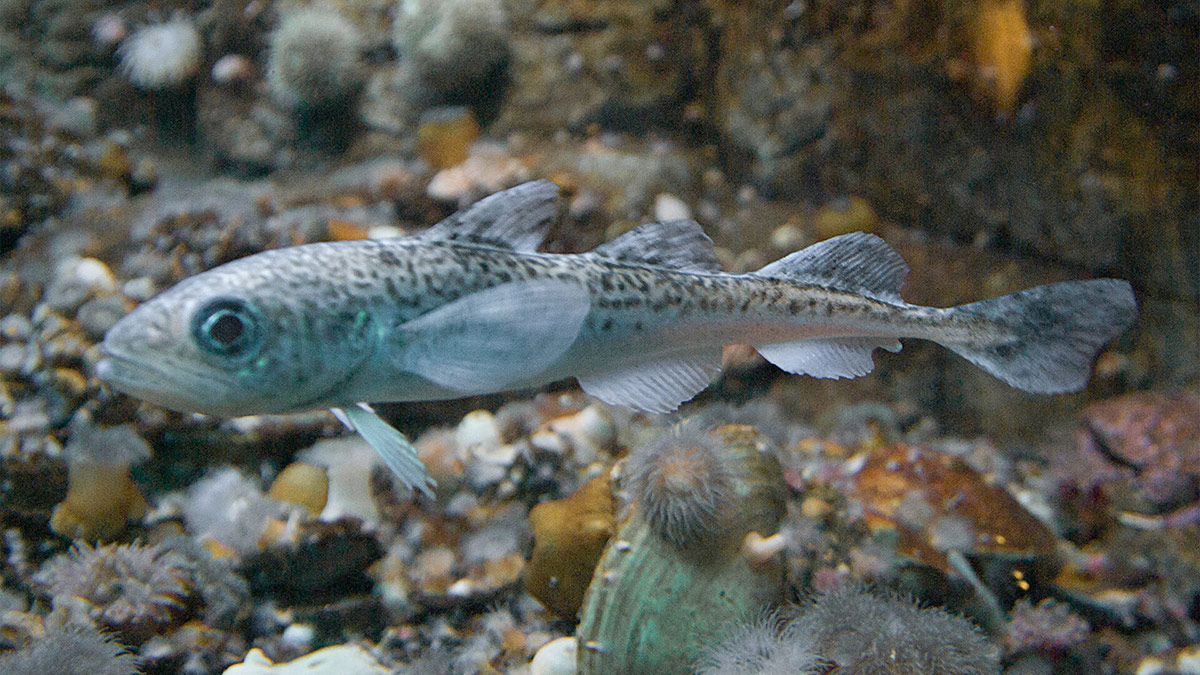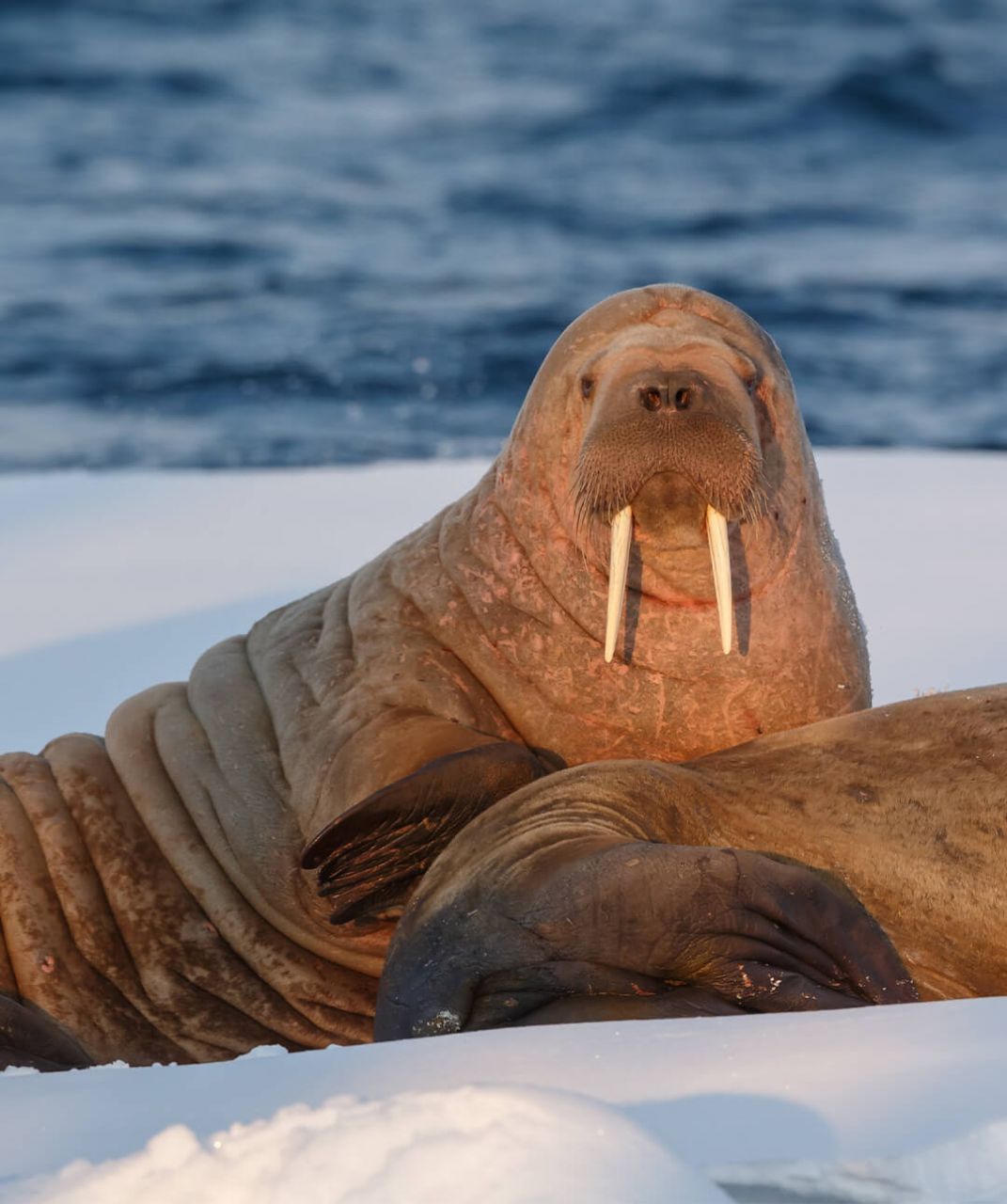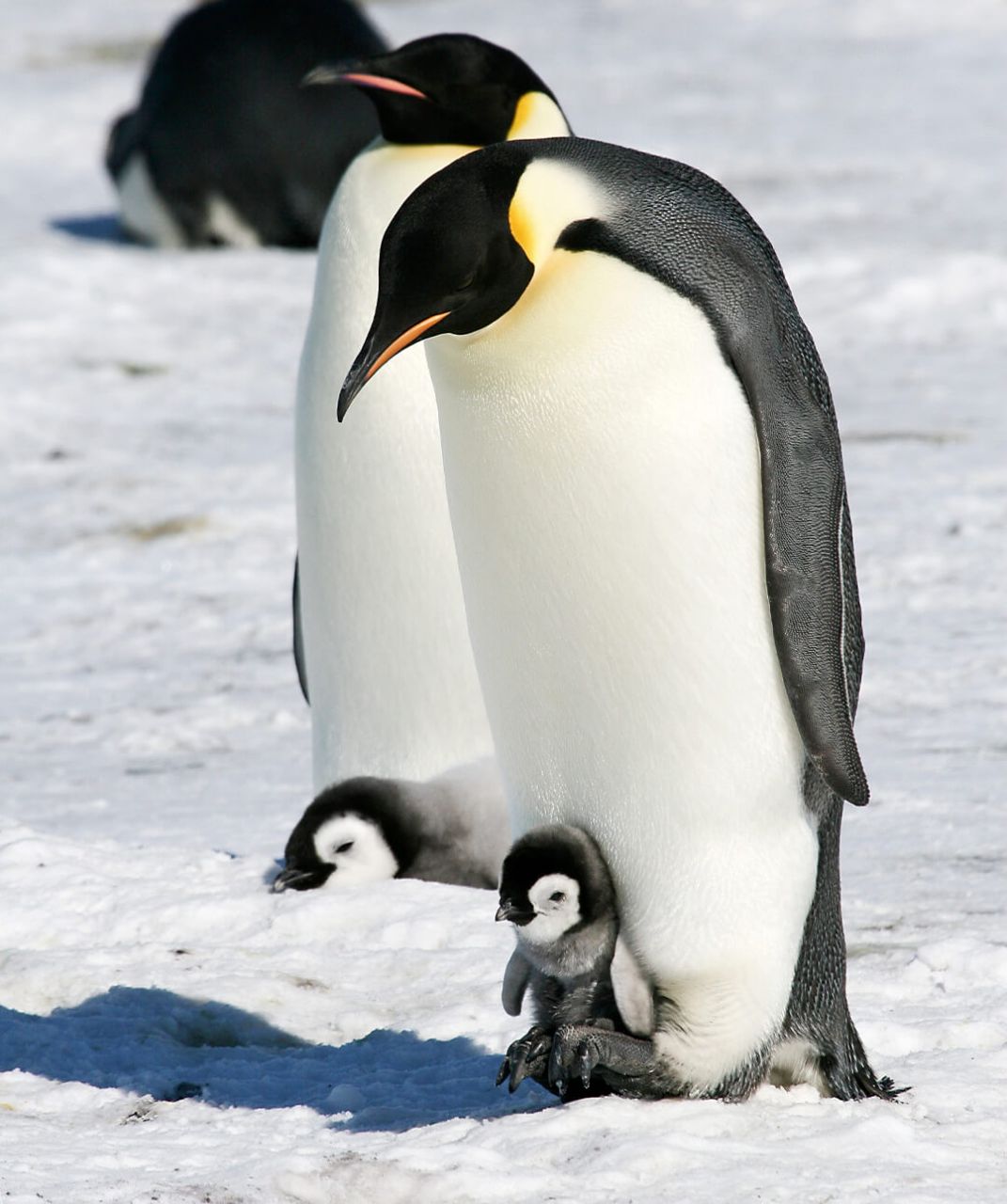The Arctic



Arctic Foxes
SCIENTIFIC NAME
Vulpes lagopus
LOCATION
Arctic (Terrestrial)
IUCN CLASSIFICATION
Least Concern (stable)
- Arctic foxes have alternative names – white foxes, polar foxes, snow foxes – depending on their geographical location and color.
- Arctic foxes don’t hibernate. But they do significantly lessen their locomotive activity in the winter. Their reserve fat stores provide insulation in colder temperatures.
- Arctic fox dens are used over many generations. Some are over 300 years old!



Arctic Hares
SCIENTIFIC NAME
Lepus arcticus
LOCATION
Arctic (Terrestrial)
IUCN CLASSIFICATION
Least Concern
- The beautiful white coats of Arctic hares protect them against harsh winters, both by keeping them warm and by providing camouflage against predators like foxes, wolves and owls.
- Arctic hares use both their feet and their noses to find food. They identify food with their strong sense of smell and use their long, snowshoe-like feet to dig beneath the snowy surface for lichens and woody plants.
- Arctic hares have good vision. Their extremely wide eye placement allows for an almost 360° range of sight.



Beluga Whales
SCIENTIFIC NAME
Delphinapterus leucas
LOCATION
Arctic (Marine)
IUCN CLASSIFICATION
Near Threatened
- Beluga whales are extremely social animals who live in groups called pods. The beluga’s flexible head bulge, called a “melon,” can change shape as an aid to facial expression and communication.
- Beluga whales are quite talkative. They communicate with each other through clicks, whistles, chirps and squeals.
- Beluga whales are one of the few species of dolphin or whale that can move their heads up, down, and side to side!



Lophelia Coral
SCIENTIFIC NAME
Lophelia pertusa
LOCATION
Arctic (Marine)
IUCN CLASSIFICATION
Unknown
- Unlike shallow-water corals that feed on algae inside their cells, Lophelia coral are filter feeders. They feed on phytoplankton floating in the deep-sea currents.
- Lophelia coral build reefs in the deep sea, at depths from 3,000 to 10,000 feet.
- Lophelia coral are very slow growing, but can live for thousands of years!



Musk Oxen
SCIENTIFIC NAME
Ovibos moschatus
LOCATION
Arctic (Terrestrial)
IUCN CLASSIFICATION
Least Concern (Stable)
- Musk oxen get their name from the strong odor emitted by the males during mating season.
- Both male and female musk oxen have large, curved horns they use for fighting off other musk oxen and potential predators.
- When danger is present, musk oxen will form a defensive barrier in the shape of a ring or semicircle to protect the herd.



Polar Bears
SCIENTIFIC NAME
Ursus maritimus
LOCATION
Arctic (Terrestrial, Marine)
IUCN CLASSIFICATION
Vulnerable (Population decreasing)
- Polar bears’ skin is black. Their “white” fur is actually translucent and they only appear white because of the light reflected by their fur.
- Polar bears have an impressive sense of smell. They can smell their prey from a mile away and under more than three feet of snow.
- Polar bears are master swimmers. They can swim long distances at more than 5 miles per hour, stopping periodically to rest on ice floes. The alarming decline in Arctic floe ice due to climate change is a serious threat to the species.



Polar Cod (AKA Arctic Cod)
SCIENTIFIC NAME
Boreogadus saida
LOCATION
Arctic (Marine)
IUCN CLASSIFICATION
Least Concern (stable)
- Polar cod are some of the most abundant fish in the Arctic. They have a glycoprotein that serves as a sort of antifreeze, allowing the fish to survive in frigid waters.
- When ice is abundant, polar cod hide from predators in the cracks. When ice is less abundant, polar cod move in large groups called schools.
- Polar cod are mostly found at the water’s surface. But they can dive to depths of 3,000 feet.



Reindeer / Caribou
SCIENTIFIC NAME
Rangifer tarandus
LOCATION
Arctic (Terrestrial)
IUCN CLASSIFICATION
Vulnerable (Population decreasing)
- Reindeer and caribou are the same species! The difference in name and behavior reflects their geographical location: reindeer live in Europe and Northern Asia while caribou reside in North America.
- Reindeers’ noses contain blood vessels whose purpose is to regulate temperature, including warming cold air as it enters on inhalation. This keeps the reindeer’s brain constantly warm and active. On thermal cameras, reindeer noses really do glow red!
- Caribou have hooves that are hollow underneath, allowing them to dig beneath the snow for food. In fact, the name "caribou" is the French fur trappers' mispronunciation of the native Micmac word "qalipu" which means "snow shoveller."



Snowy Owls
SCIENTIFIC NAME
Bubo scandiacus
LOCATION
Arctic (Terrestrial)
IUCN CLASSIFICATION
Vulnerable (Population decreasing)
- Young snowy owls, both males and females, have some dark coloring that fades as they mature. Females keep vestiges of their dark barring. The brightest white owls are males.
- Unlike many species of owl, snowy owls are diurnal. They hunt during the daytime.
- Snowy owls might look familiar to fans of Harry Potter! Harry’s owl, Hedwig, was an adult male snowy owl.



Sunflower Stars
SCIENTIFIC NAME
Pycnopodia helianthoides
LOCATION
Arctic (Marine)
IUCN CLASSIFICATION
Critically Endangered (Population decreasing)
- Sunflower stars are born with 6 arms, but can develop up to 24 arms (and 15,000 tube feet) by full maturity.
- By sea star standards, sunflower stars are very fast, moving at speeds of over 40 inches per minute.
- Sunflower star skeletons show some disconnected components which allow them to open their mouths wide enough to eat whole sea urchins.



Walruses
SCIENTIFIC NAME
Odobenus rosmarus
LOCATION
Arctic (Terrestrial, Marine)
IUCN CLASSIFICATION
Vulnerable (Population trend unknown)
- Walruses are known for their long tusks and long, coarse, sensitive whiskers. Walruses use their tusks for dominance displays and fighting, to break breathing holes in the ice, and to pull themselves up out of the water and onto the ice.
- Walruses have an air sac under the throat that inflates to help them float in the frigid waters while they sleep.
- Walruses have a substantial layer of blubber beneath their skin to keep them warm in the frigid waters and to serve as an energy resource when food is scarce.
The Poles



Arctic Terns
SCIENTIFIC NAME
Sterna paradisaea
LOCATION
Arctic and Antarctic (Terrestrial)
IUCN CLASSIFICATION
Least Concern (population decreasing)
- Arctic terns are known for their yearly migration. They fly from the Arctic to the Antarctic and back again, allowing them two summers annually and more exposure to daylight than any other animal.
- Arctic terns typically keep the same mate and breeding location for life.
- Arctic terns have relatively long lifespans. They live for 15-30 years.



Orcas
SCIENTIFIC NAME
Orcinus orca
LOCATION
Arctic and Antarctic (Marine)
IUCN CLASSIFICATION
Data Deficient
- Orcas can be found in every ocean on Earth.
- Often called "killer whales," orcas are actually members of the dolphin family.
- Orcas are very smart and very social. They live and hunt in groups called pods.



Phytoplankton (Microalgae)
SCIENTIFIC NAME
Two main classes: dinoflagellates and diatoms
LOCATION
Arctic and Antarctic (Marine)
IUCN CLASSIFICATION
Unknown, but threatened by rising sea temperatures
- Phytoplankton, consisting of ice algae and bacteria, form the foundation of the marine food chain.
- Phytoplankton blooms occur in warm weather, as the sun penetrates and melts sea ice.
- Phytoplankton are so abundant that scientists can view and study them from space via satellites.
The Antarctic



Adélie Penguins
SCIENTIFIC NAME
Pygoscelis adeliae
LOCATION
Antarctic (Marine)
IUCN CLASSIFICATION
Least Concern (Population increasing)
- Adélie penguins are the smallest and most widely distributed penguins in Antarctica.
- Adélie penguins are small, but they have big attitudes! They’ve been known to take on larger predators and even attack human researchers.
- When they’re ready to breed, Adélie penguins make a nest of collected stones and lay two eggs.



Antarctic Blue Whales
SCIENTIFIC NAME
Balaenoptera musculus intermedia
LOCATION
Antarctic (Marine)
IUCN CLASSIFICATION
Critically Endangered (Population increasing)
- Blue whales are the largest animals on the planet, weighing up to 200 tons.
- They are also the loudest animals on the planet! Their calls can reach 188 decibels and be heard hundreds of miles away underwater.
- Commercial whaling and climate change are the largest threats to Antarctic blue whales.



Antarctic Krill
SCIENTIFIC NAME
Euphausia superba
LOCATION
Antarctic (Marine)
IUCN CLASSIFICATION
Least Concern (Stable)
- Antarctic krill go to extremes to survive the cold, dark waters of the Southern Ocean. These crustaceans can survive more than 200 days without food!
- Contrary to popular belief, krill are not microscopic. Antarctic krill can weigh up to 1 gram and can reach 6 centimeters in length.
- Antarctic krill is one of the most abundant species in the world. There are more than 400 million tons of krill in the Southern Ocean alone.



Blackfin Icefish
SCIENTIFIC NAME
Chaenocephalus aceratus
LOCATION
Antarctic (Marine)
IUCN CLASSIFICATION
Not evaluated
- Blackfin icefish are the only known vertebrates that lack red blood cells to help distribute oxygen through their bodies. Icefish blood is clear and their hearts are white.
- Blackfin icefish don’t have scales like most other fish, and their bones are transparent, like their blood.
- Adult blackfin icefish are typically sedentary. They hunt only sporadically, but they can consume large quantities of food at a time.



Emperor Penguins
SCIENTIFIC NAME
Aptenodytes forsteri
LOCATION
Antarctic (Marine)
IUCN CLASSIFICATION
Near Threatened (Population stable)
- Emperor penguins are the largest living penguin species.
- Emperor penguins have special adaptations to help them hunt. They can stay submerged for up to 20 minutes without oxygen and dive to depths of over 1,700 feet.
- Emperor penguins are the only penguins that breed during the harsh Antarctic winter.



Humpback Whales
SCIENTIFIC NAME
Megaptera novaeangliae
LOCATION
Antarctic (Marine)
IUCN CLASSIFICATION
Least Concern (Population increasing)
- Humpback whales are among the most active whales. Their activity level is measured in number of breaches (breaking the water’s surface), tail and fin slaps, and mating/courting behaviors.
- Humpback whales have the longest annual migration of any whale species, starting from the Antarctic Peninsula and crossing the equator.
- Humpback whale songs are typically used for courting. The whales sing short songs that can be repeated multiple times, in sessions that can last for hours.



Southern Elephant Seals
SCIENTIFIC NAME
Mirounga leonina
LOCATION
Antarctic (Marine)
IUCN CLASSIFICATION
Least Concern (Population increasing)
- Southern elephant seals are the largest seal species and largest marine mammal that is not a cetacean.
- Southern elephant seals get their name from the large protruding nose or snout, called a proboscis, on males, which helps them roar loudly during mating season.
- Southern elephant seals are well adapted to the cold. They breed on land, but most of their time is spent in the frigid waters of the Antarctic.



Swimming Sea Cucumbers
SCIENTIFIC NAME
Enypniastes eximia
LOCATION
Antarctic (Marine)
IUCN CLASSIFICATION
Not evaluated
- Because of their odd appearance, swimming sea cucumbers have accumulated many different nicknames, like "headless chicken fish," "headless chicken monster," "Spanish dancer," and "pink see-through fantasia."
- For aid in finding food and avoiding predators, swimming sea cucumbers have developed webbed, fin-like body parts for swimming.
- These sea cucumbers descend to the seafloor to feed. They eat very quickly, remaining on the seafloor for one minute at most while they shovel food into their mouths with their tentacles.



Wandering Albatross
SCIENTIFIC NAME
Diomedea exulans
LOCATION
Antarctic (Marine)
IUCN CLASSIFICATION
Vulnerable (Population decreasing)
- Wandering albatross have the longest wingspan of any bird on earth, reaching lengths of over 11 feet!
- Because of its amazing wingspan, the wandering albatross can soar and glide through the air for hours without flapping its wings.
- Wandering albatross spend most of their lives in the air. They return to land to feed and to breed. Pairs mate for life and breed every two years.



Weddell Seals
SCIENTIFIC NAME
Leptonychotes weddellii
LOCATION
Antarctic (Marine)
IUCN CLASSIFICATION
Least Concern
- Weddell seals have a thin coat of fur that covers their whole body, except for small patches around their flippers.
- Weddell seals’ coats change color as they age. Their coats also can change color seasonally, and they molt annually before summer.
- During warmer weather, Weddell seals typically live on ice that is attached to land, known as “fast ice.” In the winter, the seals stay submerged in water to avoid harsh weather. Cracks and holes in the ice allow them to breathe.
Credits

Danielle Broza, Digital Lead
Amanda Schmidt, Digital Producer
Fred Kaufman, Executive Producer
Bill Murphy, Series Producer
Janet Hess, Series Editor
Digital at The WNET Group
Victoria Malabrigo, Creative Direction
Brian Santalone, Senior Web Specialist
Special Thanks
Chelsey Saatkamp, Audience Engagement Sr. Specialist, The WNET Group
Karen Ho, Sr. Social Media Specialist, The WNET Group
Blanche Robertson, Deputy General Counsel, The WNET Group
Jayne Lisi, Budget Controller, The WNET Group
Marcia Young, Copy Editor, The WNET Group

PBS is a 501(c)(3) not-for-profit organization.

NOAA
NOAA's mission is to understand and predict changes in climate, weather, ocean, and coasts, to share that knowledge and information with others, and to conserve and manage coastal and marine ecosystems and resources.
Photo Credits
"Boreogadus saida" by Claude Nozères, CC BY-SA 4.0
"Sun flower sea star in tide pools" by Brocken Inaglory, CC BY-SA 4.0
"Lophelia pertusa budding" by NOAA Ocean Exploration, CC BY-SA 2.0
"Blue whale" by NOAA Fisheries/Kelly Houle
"Icefish Larvae" by Uwe Kils, GNU Free Documentation License
"Enypniastes eximia" by NOAA Office of Ocean Exploration and Research
"Benthopelagic sea cucumber" by NOAA Okeanos Explorer Program
"Antarctic krill" by Uwe Kils, GNU Free Documentation License



